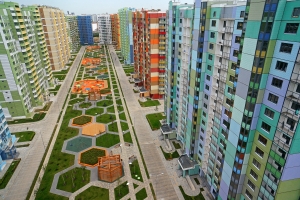End of XX - early XXI centuries, associated with the rapid development of information technology, was marked by the emergence of a fundamentally new approach in architectural and construction design, which consists in creating a computer model of a new building that contains all the information about the future object - Building Information Model(BIM). Despite the fact that the idea was first formulated back in 1975 by Georgia Institute of Technology professor Chuck Eastman, it is the current period that accounts for the massive discussion and implementation of BIM technology in design and construction.
Building Information Model
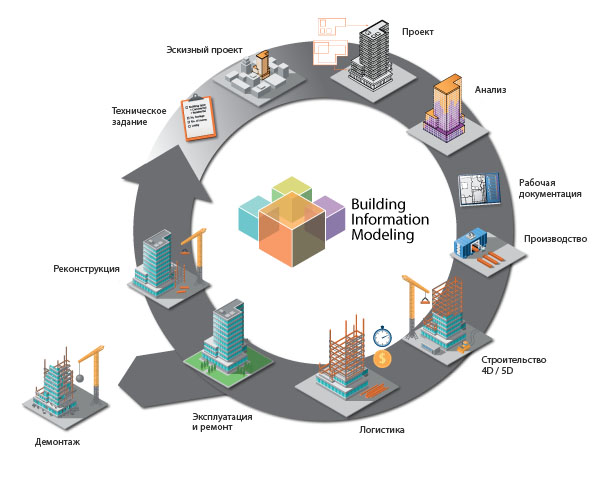
It is important to note the fact that business processes in our region and in Western countries have significant differences, which in turn affects design approaches. Therefore, the tools offered by vendors may not always be applicable in our realities in pure form and require improvement. In this matter INFARS group of companies is ready to help our customers, both in the selection of tools for specific tasks, and in the creation of various kinds of adaptations. Our experts have real experience conducting complex projects for the implementation of CAD and BIM technology.
BIM technologies
Entrust the implementation of BIM to professionals
Tell us about your project and we will prepare a commercial offer
Novokovsky Konstantin
BIM technology of information modeling of objects (Building Information Modeling) is a development of the computer-aided design (CAD) system generally accepted today. The main difference from the latter, in addition to three-dimensional drawing, is that the model has a database containing detailed information about the technological, technical, architectural, engineering, construction, cost estimates, and economic characteristics of the object. Depending on the specific requirements, the database can be supplemented with legal, operational, environmental and other information.
BIM design principles
The postulates of information modeling or BIM design, which formed the basis of the modern approach to development project documentation, was identified and applied during the reconstruction of Heathrow Airport Terminal 3 in the late 80s by the developer of software systems for Autodesk and Bentley Systems, Robert Aish. As the basic principles of BIM, he named:
- constructing an object in three-dimensional space;
- the possibility of automatic issuance of drawings and specifications;
- the presence in the model of all the design data of the object;
- intelligent parameterization;
- the possibility of modeling the construction process with reference to time and budgeting.
By combining all sections and decisions of the project in a single multidimensional space, the manager can see the results of construction before it starts. When talking about BIM design, along with the generally accepted term "3D visualization", "4D" and "5D" are often used. This means, in the truest sense of the word, the expansion of the number of spatial dimensions, which is provided by linking the model to the construction schedule and the estimated cost of the facility.
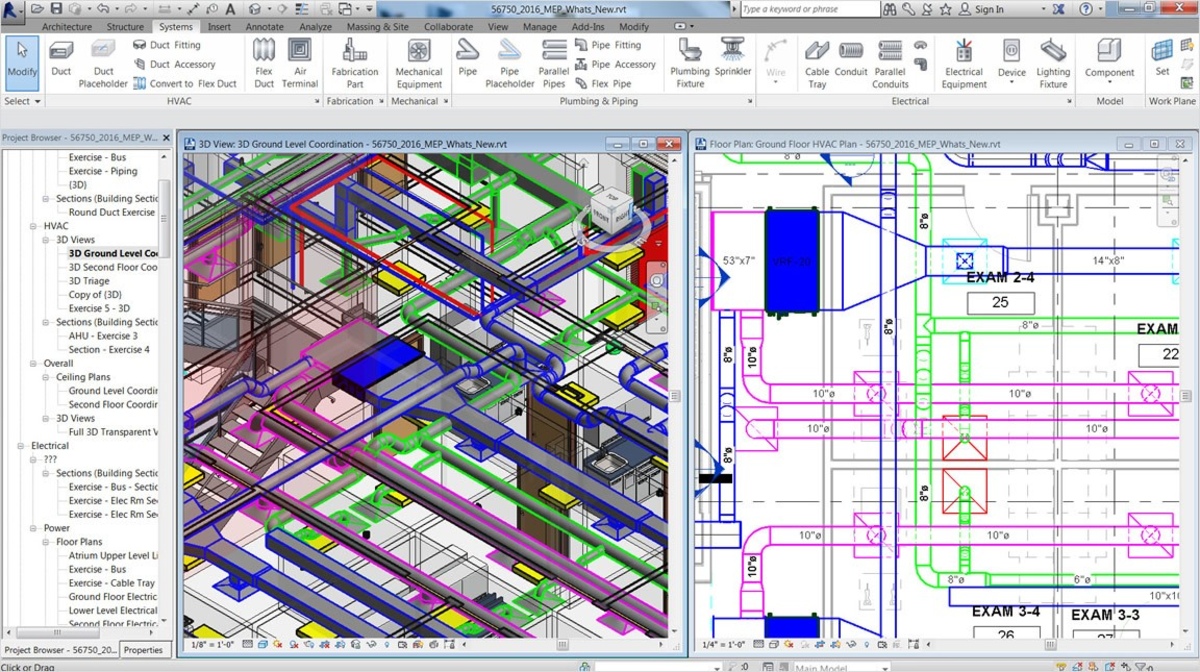
World development experience
As noted above, the development of information modeling systems abroad has been carried out since the 80s of the last century. One of the leaders and founders of the movement was Autodesk, whose achievements served as an impetus for the creation of an alliance for the interaction of various graphics platforms.
Alliance of Interoperability includes 12 major developers software, including Autodesk (Revit, Autocad), Tekla, Graphisoft (Archicad), Trimble (Sketchup) and others. For correspondence between different platforms, the IFC data format with an open specification is used.
Today, almost all eminent architects and design studios work with BIM design technologies. In accordance with analytical studies, the use of modern approaches in design and construction makes it possible to achieve tangible savings in terms of construction and installation works, the cost of construction and operation of facilities.
For example, during the construction of the art museum in Denver under the project of D. Libeskind in 2006, thanks to the created model of interaction between contractors linked to the network schedule, the overall implementation time was reduced by 14 months. Significant results were achieved through the introduction of BIM in the construction of the highest music school in Miami designed by Frank Gehry in 2008.
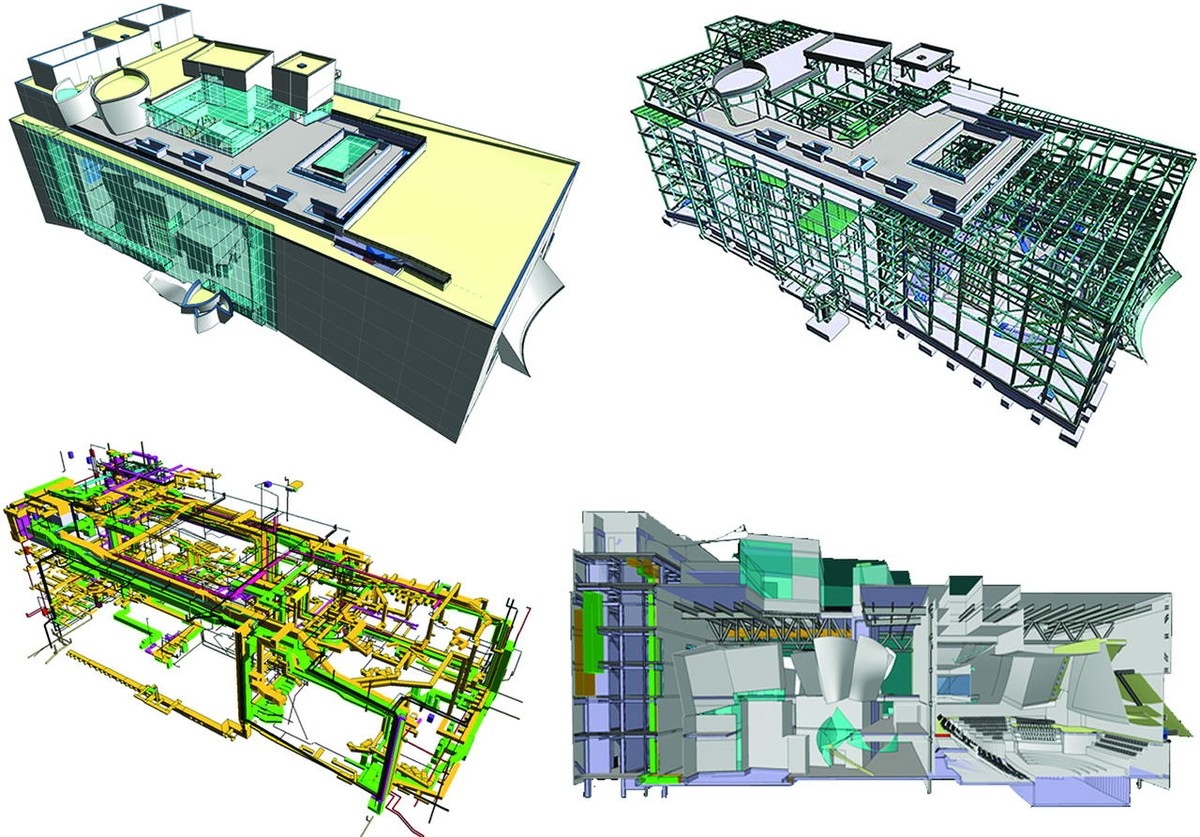
According to research data from McGraw-Hill Construction, the level of involvement of US and Canadian design bureaus in BIM technologies in 2007 was 28%, in 2009 - 49%, in 2012 - 71%. In the United States, the American National Bureau of BIM Standards, which is part of the National Institute of Buildings, is moving towards information modeling.
In many European countries, the introduction of advanced BIM technologies is carried out by purposeful actions of the authorities. In particular, in the UK back in 2010 an action plan was approved, according to which, starting from 2016, all state-funded construction projects must be developed in accordance with BIM standards. In addition, the recessionary trends in the EU economy created the conditions for design and construction organizations to search for new, more efficient approaches to the execution of work. With the forced reduction in the number of participants in the project, BIM technologies turned out to be an effective way to survive.
BIM: advantages and opportunities
So, the term BIM design today is understood as an information model of an existing or planned facility, distinctive features which are:
- interconnectedness and consistency of all elements;
- the possibility of supplementing, changing, analyzing and forecasting development;
- binding to real time and place;
- access for simultaneous work by specialists of various fields and the possibility of combining their technical solutions in a single space.
The main advantages of using BIM follow from this definition. Modeling benefits include:
- the possibility of automatic creation of high quality design and estimate documentation;
- no errors in drawings, dimensions, specifications, estimates;
- up-to-date information on operational and cost indicators of materials;
- visual clarity, contributing to the adoption of optimal technical solutions;
- ease of managing the construction and operation of the facility;
- availability of up-to-date data for the possibility of reconstruction, technical modernization and demolition of buildings and structures at the end of their life cycle.
An important component of the innovative BIM approach is the possibility of visual modeling of the construction process itself, during which each of the specialists participating in the project can track the implementation of the technical solutions laid down by him and their interaction with subcontractors. When modeling the operation of an object, it is possible to observe the operation of the equipment provided for by the project and draw conclusions about the satisfaction of its parameters.
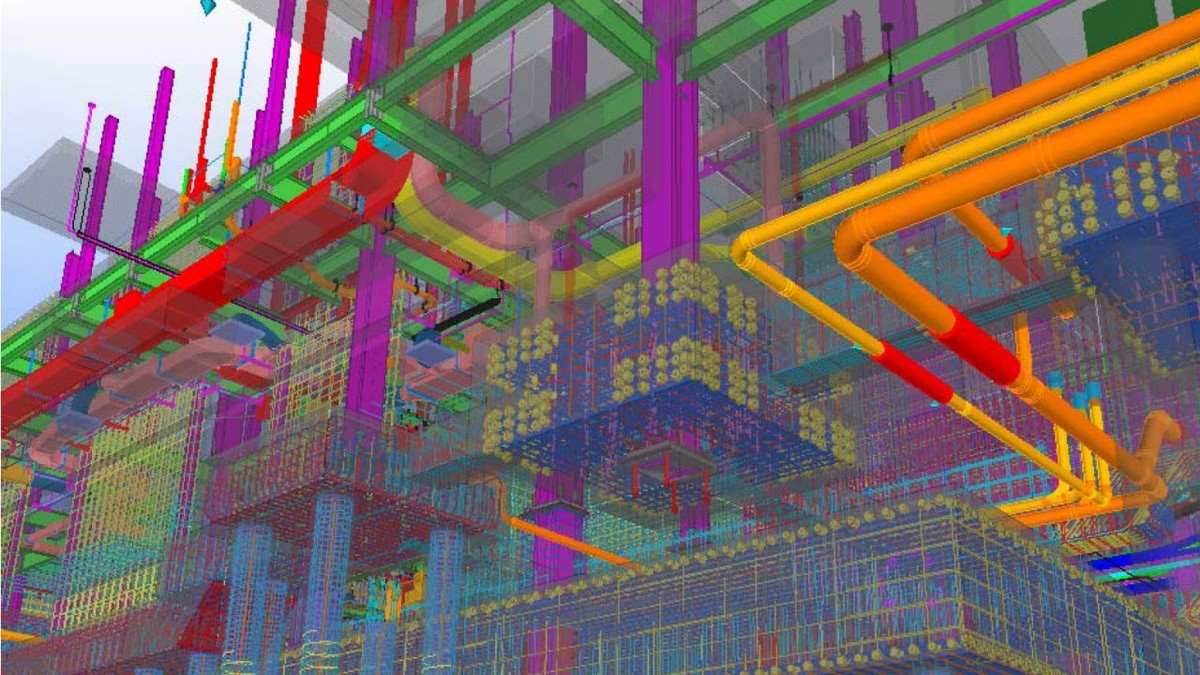
Implementation of BIM in the domestic construction industry
Speaking about the implementation and development prospects of information modeling in Russia, it is necessary to highlight several main factors that influence this process. On the one hand, there are a number of companies interested in development who, by promoting BIM technologies at their facilities, strive to be at the forefront of construction technologies.
On the other hand, there are centralized programs of the authorities aimed at a phased transition to more progressive systems of design and construction. At the same time, there are certain forces and circumstances that impede these positive processes. Let's look at each of these points in more detail.
Who promotes BIM design technologies in Russia
One way or another, most designers and builders have heard at least something about information modeling. For many, BIM design is associated primarily with 3D design. At the same time, things often do not go beyond the realization that the new technology is the future. Nevertheless, there is already a core of interested companies in the domestic market that are actively promoting the introduction of innovations.
One of the pioneers in the use of BIM in Russia is the Design Bureau for High-Rise and Underground Structures (St. Petersburg). Using modeling methods, the bureau has developed over 70 objects of varying degrees of complexity. Among them are complex projects for the stage of the Mariinsky Theatre, a 120-story skyscraper in Azerbaijan, shopping center in Minsk and others.
One of the largest domestic developers, Morton Group of Companies (Moscow) uses BIM technologies not only to optimize construction and installation works, but also to plan the entire life cycle of objects under construction. One of the company's pilot projects was the construction of a kindergarten.
The Etalon Group of Companies (St. Petersburg) has now implemented an information modeling system at all its construction sites. Active supporters of the introduction of BIM technologies are foreign companies that have their offices in Russia. Among them are NCC (Sweden), YIT (Finland) and a number of others.
State regulation and expertise
The program for the implementation of construction information modeling was approved by the Ministry of Construction of the Russian Federation in December 2014. In accordance with this document, the development of technology consists of the following stages:
- development of 23 pilot BIM projects. The models are currently under review;
- examination of pilot projects and analysis of results. Deadline - until the end of 2015 (work in progress);
- development of a BIM classifier containing about 70 thousand items of building materials;
- creation of a list of the regulatory framework that needs to be adjusted when introducing information modeling by the end of 2015;
- adjustment building codes and rules - during 2016;
- starting from 2017 - a mandatory requirement for the use of BIM in the implementation of part of state orders for design;
- starting from 2018, the Ministry of Construction will give recommendations on the use of BIM technologies by construction contractors;
- further increase in the percentage of modeling in the design and construction of facilities.
Currently, within the framework of pilot BIM projects, interaction between their developers and experts is being adjusted. Since April 2015, the state expertise, along with the classic technical documentation in paper form, has also been accepting models of objects for consideration. For these purposes, the staff of the state structure has trained specialists, as well as equipped workplaces. The Revit Autodesk complex is currently the main tool for designers and experts.
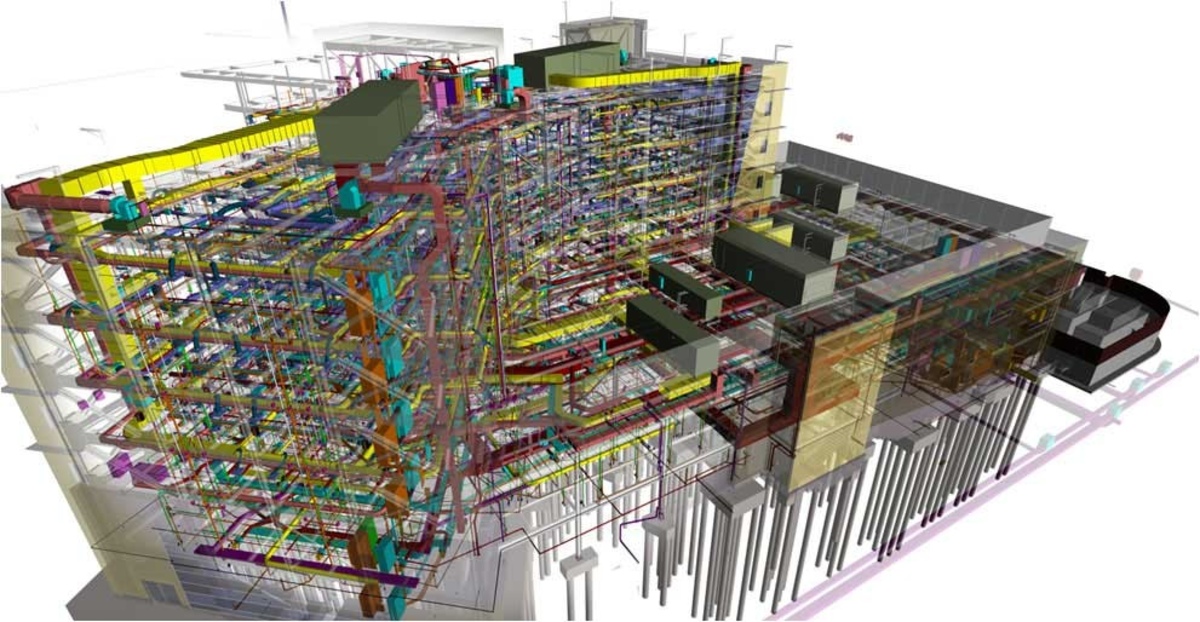
Features of the implementation of BIM design technology in Russia
When studying the issue of introducing BIM technologies, most often come across positive reviews and a detailed description of the benefits of a more advanced system. Nevertheless, among domestic specialists (designers and builders) there are also a sufficient number of skeptics. And there are indeed reasons for negative perception of the process.
Despite the unified approach to BIM basics proclaimed by software developers and the free exchange of information between Autodesk, Bentley, Tekla, Graphisoft and others platforms, it is not possible to actually fulfill this condition without losing a significant part of the data today. In fact, a design organization that has adopted a particular software package becomes a hostage of its manufacturer.
At this stage of development, in many cases there is no established connection between the calculation systems and the visual construction of the model. It is very problematic to fit information about defects into a single BIM system building structures existing buildings and structures requiring repair and reinforcement. Therefore, today it is not necessary to talk about a comprehensive process of modeling an object.
A certain skepticism is also caused by the assertion that the kits working documentation are “cut” automatically from the finished model without the participation of the “human factor”, and the possibility of errors in this process is minimal. The practice of using the same Revit Autodesk indicates the need for significant "manual" revision of the drawings in terms of bringing them to the SPDS standards. Users claim that the out-of-the-box version of the software package requires a significant amount of time to customize it to suit your needs, creating your own databases, stamps and forms.
Despite the assurances of the developers, the use of BIM technology is not justified in all cases. Building an information model is a rather laborious and lengthy process that can be justified in large-scale projects. The development of the design of small objects using BIM will simply increase the time and cost of the work. Apparently, in order to justify cases of inefficient use of technology, developers are actively promoting the idea of using the model at all stages of the life cycle of an object, up to its demolition.
In addition to these "pitfalls", the process of implementing BIM in domestic design and construction organizations faces the following problems:
- high cost of transition from CAD-systems to information modeling. Often, the company's management does not realize the need to use licensed products and specialized staff training;
- negative reaction of the company's employees when imposing additional duties. In most cases, the process of training specialists in modeling takes place after hours and at no additional charge;
- decrease in labor productivity and loss of time when developing pilot projects in the BIM environment.
Working under sanctions and import substitution
It just so happened that in addition to the internal problems of introducing advanced technologies, today designers are also influenced by foreign policy factors. By and large, having invested a considerable amount of money and labor in its development based on imported technology, the organization may be left with nothing.
In this regard, the Ministry of Construction is considering proposals from three domestic software developers as part of an import substitution project. Requirements for potential applicants full compatibility with world BIM technologies and support for the implementation of a software product in the environment of design and expert organizations.
conclusions
Summarizing the above, it can be noted that:
- the development of BIM technologies is a logical and irreversible process of evolution of design and construction technology;
- along with unconditional advantages, the process of introducing information modeling in Russia has a number of "pitfalls", the presence of which cannot be ignored;
- the introduction of BIM systems must be approached selectively, taking into account the specifics of a particular project. The all-or-nothing approach is not correct. In some cases, CAD systems turn out to be more effective, and the use of BIM can be carried out in a limited form (for example, three-dimensional modeling).
I have long wanted to write an article about BIM design. Previously studied the Internet about this. It turns out that a lot of interesting things have been written about this phenomenon. However, articles about BIM are written mainly by software vendors of this very BIM. I decided to write an article from the point of view of a designer, a user of this technology. The topic is very important and exciting! I think that this article will serve as the beginning of a whole series of my articles on BIM design.
What is BIM design?
First of all, I will give a brief understanding of what BIM is. The abbreviation BIM stands for Building Information Modeling, which translates as "building information modeling".
If you explain in simple words, then we can say that with this approach to design, a 3-dimensional model of the building is created, from which various information is then extracted. For example, design scheme, working documentation with statements and specifications, a bill of quantities or even a ready estimate. You can also say that the designer creates a 3-dimensional model, and all other documentation is created automatically. In addition, the design scheme, working documentation, estimates - this is not the whole list of attributes that are contained in a 3-dimensional building model. Also, on the basis of a 3-dimensional model, for example, a production schedule can be built construction works, accounting, etc. In general, the meaning of BIM is to create a virtual model of the building as close to reality as possible and, based on this model, automatically release all the necessary documentation for construction and passing through various instances. In addition, BIM is also a certain principle of work of related designers - architects, designers, engineering network specialists, technologists, etc. According to BIM, they all work in a single linked model. For more information about what BIM is, I recommend reading Wikipedia.
Here is a practical example of how BIM should work:
1) The architect creates a 3D model of the building and extracts from it plans, sections and other components of the section " Architectural solutions”, which are created automatically in the program.
2) The designer loads the 3D model created by the architect into the calculation program, which determines the required sections of the calculation elements, the required degree of reinforcement, etc. Based on these data, the designer assigns the appropriate attributes to the building elements - rolled metal profiles, diameter and pitch of reinforcing bars. At the same time, the program immediately generates working drawings, statements, specifications, and also simultaneously creates a bill of quantities and calculates the estimate.
3) Engineering network specialists receive from the architect and designer all the necessary information to develop a network project. For example, heat losses through the enclosing structures of a building, etc. can be automatically calculated. Engineering networks are also added to the 3-D model.
4) Specialists in the development of POS and PPR receive the exact amount of work, while the calendar schedule for the production of work is automatically built, the specialist only needs to adjust it at his own discretion. Next, logistics is connected - suppliers receive information about when and what material needs to be delivered to the construction site.
5) And finally, after the completion of construction, the 3-D model of the building created at the design stage can be connected to the building itself through special sensors - this will allow the facility to be operated efficiently, monitor its microclimate, as well as emergencies.
The most common BIM-based programs are: ArchiCAD, Revit, TeklaStructures, AdvanceSteel, DigitalProject, NemetschekAG.
What is the use of all this and who needs it?
Based on the foregoing, we can make a logical conclusion that the use of BIM technology to a large extent should facilitate the work of designers and improve the quality of project documentation and working drawings.
What does the introduction of BIM technologies mean for a design organization? Imagine that you have the opportunity to make projects of much higher quality and at the same time 4-5 times faster. Isn't that a competitive advantage? However, quality and speed are not all that can give BIM technology! Thanks to this technology, a visual 3D model of the building is created, which gives a comprehensive idea of the space-planning, design and technological solutions of the facility. Since in BIM programs in the process of creating a model, specifications, statements, estimates are automatically generated - this allows you to track the economic effect of applying a particular design solution at various stages. BIM allows you to do variant design. Is this another competitive advantage?
Will BIM - technology benefit customers of design and construction work? I think that every sane customer will not refuse to receive a project of the highest quality in a short time and at a lower price + a visual 3D model + variant design. Let me remind you that BIM is the automatic creation of working documentation, which allows the developer to enter the construction site as soon as possible and carry out construction work in parallel with the design.
Among other things, BIM - technology should allow for instant and accurate verification, examination of projects, and most importantly, simple and accurate control at all stages of design and construction. Thus, not only designers, builders and private investors are interested in using BIM, but also the State (if, of course, it cares about saving its resources).
What slows down the implementation of BIM?
Why, if everything is so cool and beautiful, BIM - design stalls and does not become a ubiquitous, generally accepted standard? Moreover, the point here is by no means that this technology has appeared quite recently and has not yet had time to get used to it. In fact, BIM, which is often presented as know-how, did not appear yesterday .. and not even the day before yesterday. For example, one of the first programs working on this technology is the ArchiCAD software package. Many will probably be surprised to learn that this complex has been on the market since 1984!
There are several reasons for the slowdown:
1) Imperfection of BIM software.
This is perhaps the main argument of critics of BIM technology, and the argument is not without foundation. Indeed, BIM programs have many problems with the release of project documentation that would comply with Russian standards. In addition, programs give out various glitches and errors (the latter, of course, occurs most likely due to the use of hacked unlicensed versions of programs).
2) BIM software is very expensive.
A striking example of an expensive program based on BIM technology is Tekla Structures, for which the cost of one workplace reaches one million rubles! With all the desire, an average design organization is unlikely to be able to afford the installation of even one licensed version of Tekla Structures.
3) Difficulty in mastering BIM.
In general, the first impression of a person who has switched from AutoCAD to any BIM program is the horror of the fact that he does not understand at all how to work in it. When you “wrestle” with Revit or Tekla Structures for several days, trying to create a simple model, your hands drop .. and you want to spit on all this BIM and return to your good old AutoCAD “drawer”. True, I immediately recall the phrase from the AutoCAD tutorial, sometime in 2003: “Before you learn how to effectively use all the AutoCAD tools, it will seem to you that drawing by hand is much easier than working in the program.” That is, in a sense, you can draw an analogy with how a designer had to “break” himself by switching to AutoCAD, when he drew on a drawing board all his life, and how now an engineer has to change his mind, changing from AutoCAD to BIM. The biggest challenge when working with BIM is solving non-standard tasks. For example, if in AutoCAD using simple tools you can draw absolutely any node (albeit for a long time, dreary, but possible), then in any BIM program it will not be possible to solve the problem in this way and you will have to seriously rack your brains, and the most annoying thing is that for all efforts may or may not result.
4) Conservatism of designers.
Despite all the difficulties in mastering BIM, there are still enthusiasts who break stereotypes and begin to do in BIM what previously seemed completely impossible to most. But this is more the exception than the rule. Usually, I hear from engineers that such-and-such a program is not intended for the development of such-and-such drawings (despite the fact that the software manufacturer claims otherwise). And there is also a category of “experienced” engineers who generally keep aloof from BIM, call this technology “heresy” and believe that 2D drafting is the only true design and we can’t get away from AutoCAD. Such terry conservatism very much reminds me of a cabman at the dawn of the birth of automobiles, who looked with a grin at the iron "miracle of technology", stalling and breaking at every corner. He probably also thought that his horse was an eternal vehicle, from which there was no getting away.
5) The absence of BIM in the educational programs of educational institutions.
I will not talk about all universities, but I know that in many even AutoCAD is studied at an amateur level, what can we say about BIM. I'm afraid some teachers don't even know what it is.
In general, the separation of the education system from reality is a very big problem.
6) Lack of initiative of the State in the implementation of BIM.
Despite the fact that (as I wrote above), the State seems to be interested in BIM technology being widely used in design, so far there are no initiatives from the state. structures are not visible ... But, for example, in the UK, from 2016, project documentation will be required to pass the instances in the BIM format and nothing else. Why? Yes, because it will significantly reduce both the time for passing examinations and the material costs associated with it. I would like to believe that sometime in the Russian Federation, an era of economic expediency and common sense will also come ...
At what stage is BIM currently in Russia?
Despite all the difficulties that adherents of BIM design have to face, there are certain shifts in the penetration of this phenomenon into the expanses of our vast Motherland. I am not a BIM software vendor, so there is no benefit for me to compose or embellish anything. Also, I did not conduct any statistical research, my opinion is based only on my own observations. In short, I write what I see:
- BIM technologies are most clearly manifesting themselves now in the development of KMD drawings. Here you can already find a lot of experienced specialists from Tekla Structures, Advance Steel, and they are really pushing those who are used to working in 2D the old fashioned way. In general, to anyone who doubts that BIM technologies are capable of replacing two-dimensional design, I recommend that you take a closer look at the development of KMD drawings.
- BIM technologies are actively used by architects. I think this is due, first of all, to the fact that a 3D model of a building is created in BIM. However, here we have to observe a mixture of the use of BIM programs and 2D editors. As a rule, a 3D model is created in BIM and sections, facades are extracted from it, which are then translated into two-dimensional space. Next, AutoCAD is launched and the finalization of the drawings to the state of design or working documentation begins.
As for the other sections of the design, there, in relation to BIM, there is still a lull. And if among the designers occasionally there are initiative engineers for whom Revit, Tekla Structures, Advance Steel have become friends, then among the engineering network specialists, I mostly observe a complete rejection of BIM. But the whole idea of BIM is precisely to create a complete model of the building with all space-planning, design and technological solutions, including engineering network solutions.
BIM Perspectives.
I have no doubt that one day BIM will completely replace the traditional two-dimensional design, as the car once crowded out the aforementioned horse or, for example, documents created in Word, crowded out handwritten documents. I won't say that 2D design will disappear completely, but its role will decrease significantly. For those who are trying to dismiss the coming changes and fiercely criticize BIM for its imperfections, I recommend going to a museum and seeing what the first cars, the first planes, the first computer were like. They were also imperfect. I think at that time, not many people believed that one day these things would seriously and for a long time enter our daily lives ... The question is how long it will take for BIM to become a reliable and simple tool in the hands of a designer. It's hard to say... It should be understood that any innovation is a long way of search and work of many people. For example, it is known that the progenitor of the computer was the loom of the 6th century, which was programmed according to the principle of punched cards. How much is left before a full-fledged arrival to BIM? Maybe 5, maybe 10 years.. But it will inevitably happen!
In conclusion, I want to paraphrase a phrase that Bill Gates once said about the Internet:
“In the future, there will be two kinds design organizations- those who have switched to BIM and those who have finished doing business.
Link to first
Building Information Modeling or Model, abbreviated as BIM, refers to building information modeling (or model) that involves the collection and use of consistent, consistent design data. BIM allows you to visualize projects, thereby visually presenting the operational characteristics of an object.
BIM technology is the creation of a building model according to certain parameters, and the 5D system is the basis of this design:
- three-dimensional modeling (3D system), is performed using certain computer programs using the initial data on the construction and engineering complex of the object. three-dimensional modeling (3D system)
- 4D - the use of an automated control system, in particular video monitoring of construction work and compliance with the network schedule. Such control allows to make the necessary decisions and adjustments on the performance of work in the shortest possible time.
- 5D - using this automated system, it is possible to accurately calculate the scope of work, material consumption, estimates and other data characterizing the technical and economic indicators of the object.
The convenience of the parametric model is that when any indicator in the calculation or design documents changes, all working documentation is automatically recalculated.
At the same time, specialized automated complexes have been developed for each group of specialists:
- For architects, the Revit Architecture complex is intended, created on the basis of building information modeling and allowing not only to accurately outline the architectural concept, but also to correct and maintain it during the design process. This greatly increases the efficiency and accuracy of the work of architects.
- For design engineers, a complex has been developed for working in the BIM environment - Autodesk Revit Structure, Robot Structural Analysis Professional. That is, according to the available data, an analytical model of Revit Structure is created, its processing takes place using the adapted calculation program Autodesk Robot Structural Analysis, both programs are mutually dependent. With the help of these programs, engineers can design models of any complexity in linear and non-linear formulations.
- For the design of plumbing, electrical and other HVAC systems, the Revit MEP complex is used, in which for the calculation engineering systems the principle of managing parametric changes is also used. The use of the above products facilitates the work of specialists and brings the design process to a new high level of performance, this allows the employees of InvestStroyProekt to develop projects of various types that are unique in complexity.
Valery Leonov on the policy in the field of estimated rationing and pricing, expert innovations and the rational use of budget money
Valery Leonov, chairman of Moscomexpertiza, became a guest of our 24th Floor column last week. He talked about the changes that have taken place in the department for recent times, on the quality of capital design, and also on the fact that last year the experts of Moscow State Expertise managed to reduce the cost of objects financed from the capital's budget by more than 15%.
What functions do Moscomexpertiza and subordinate organizations perform within the capital's construction complex?
- Moscomexpertiza is primarily engaged in the development of state policy in the field of estimated rationing and pricing in the design and construction of municipal procurement facilities. The Committee oversees the work of two subordinate organizations: Mosgosexpertiza and GAU NIATs (Research Analytical Center). We conduct an examination of project documentation and results engineering surveys for new construction facilities, reconstructed and repaired buildings, we carry out verification of the reliability of determining the estimated cost of budget facilities, as well as a public technological and price audit (TPA) of investment projects.
At the same time, GAU "NIAC" monitors prices for Construction Materials, products, structures and equipment. Develops methods for determining the norms for the duration of design and construction, special technical conditions (STU) for the preparation of project documentation. Engaged in the development of territorial estimated standards and unit rates for the cost of work.
- Since there are federal regulations, what's the point in Moscow?
- The fact is that Moscow has its own territorial estimate and regulatory base TSN-2001, it is included in the federal register of estimate standards on the basis of an order issued by the Ministry of Construction and Housing and Communal Services Russian Federation in 2014. That is, everything that is built at the expense of the city budget, we consider based on these standards, which are basic for us.
How effective is expertise today, when the economic situation in the country is so unpredictable?
- Efficiency is a relative concept. Complex and rather expensive projects can also be effective for the simple reason that there are simply no other solutions for their implementation. This is precisely confirmed or, on the contrary, refuted by us at the stages of the examination or TPA. To do this, we have to evaluate how justified each decision of the designer is in the project and whether it entails an unreasonable increase in the estimate.
- Is the issue of saving budgetary funds as relevant as ever?
- And it is very tough today. Moscow Mayor Sergei Sobyanin set us the task of optimizing the cost of construction in the capital as much as possible, both with the help of rational estimated rationing and with the help of a thorough, scrupulous examination of project documentation and engineering survey results. Last year alone, the cost of facilities financed from the budget of the capital, thanks to the work of specialists from Moscow State Expertise, was reduced by 15.6%.
- What are your actions when the project comes for examination?
- First of all, experts are appointed who will review the project documentation and the results of engineering surveys, assess their compliance with the norms and rules of technical regulations. If necessary, during the review, a set of comments on the project documentation is formed, which the customer can receive in electronic form and, even in the process of examination, adjust the project in accordance with them.
Since you are in some sense making changes to the project, the ultimate responsibility for the strength of the building or structure and its bearing capacity falls on you?
- Responsibility is not removed from either the designer or the customer. The design institute is traditionally responsible for the quality of documentation, and the customer is responsible for the reliability of the materials presented. Naturally, to some extent, the responsibility lies with us, since the examination gives a positive or negative conclusion, thereby affecting further fate project. In our competence - the validity of the issuance of a positive expert opinion, confirming the compliance of project documentation and technical regulations, and regulatory technical documents.
However, if the project repeatedly needs to make fundamental changes with each submission of documentation for examination, its developers may be summoned to the Coordinating Council for Interaction with SROs, subjected to a fine, in extreme cases they may even be deprived of accreditation.
- What are the most common mistakes in projects?
- Despite the fact that there is a regulated set of documents, which is always the same, each project has its own specifics. Therefore, comments from our side may be different.
For example, a common and very serious mistake is the project's non-compliance with the requirements of technical regulations in matters of safety. Let's say that the design justification of the design solutions adopted in the project is not presented or there is no confirmation of the safety of structures and utilities falling into the construction zone. The design of fire protection systems is also often performed with deviation from the requirements of technical regulations and fire safety standards. These are gross errors - the operation of an object built according to such documentation will simply be unsafe.
A common mistake is the lack of measures to adapt the building to the needs of people with limited mobility. Of course, this is not a question of structural reliability or fire safety, but an equally important issue, especially for wheelchair users or visually impaired people. Ensuring the accessibility of buildings for people with limited mobility is a mandatory requirement, enshrined in the Code of Rules SP 59.13330.2012, and we must not forget about it.
It is important to note that the majority of customers are interested in receiving high-quality design documentation, so they are attentive to the comments and recommendations of our experts, and they try to quickly eliminate all errors.
- How often are prices monitored?
- Monitoring of selling prices for building materials, products, structures and equipment used at construction sites in the city of Moscow is carried out by GAU "NIAC" on a regular basis. Based on the monitoring results, coefficients are developed for recalculating the estimated prices and prices of the TSN-2001 base into the current price level. Reports on the results of monitoring are published in the public domain on the official website of GAU "NIAC".
Have you come across cases when, in the opinion of experts, it is necessary to increase the estimated cost of the project?
- Yes, this is possible, but very rare and depends on changes in design decisions and adjustments to the composition of equipment and materials. This happens when the experts determine that one of the sections of the project is not fully developed. For example, the designer did not provide for the whole range of measures to ensure the accessibility of buildings and structures for people with limited mobility - he did not design a ramp, did not define a fireproof zone, etc. And with an increase in the amount of work, the estimated part of the project also increases.
If we take the data for last year, then in total for all budget facilities that passed our examination, the estimated costs were increased by 365 million rubles. However, compared to last year's savings, these are very modest funds, and each increase in cost is only to ensure the safety and reliability of facilities.
How many examinations have been carried out lately and how much budgetary funds have been saved for the city?
- In 2015, we reduced the total estimated cost of facilities financed from the capital's budget by 108.34 billion rubles. To ensure these savings, our experts reviewed 2,110 sets of project documentation and issued 703 positive opinions on budget facilities. For four months of the current year, 2278 units of project documentation have already been considered and 1642 positive conclusions have been issued. Budget savings are also impressive - 30.76 billion rubles. Such a high figure is due to the fact that we are working on the review and approval of project documentation for facilities overhaul apartment buildings in Moscow, the volumes are really serious.
What other ways are there to reduce the cost and construction time at the design stage as part of the examination?
- If we talk about additional ways to optimize estimates and design time, then in our work it is, for example, consulting services and a public technological and price audit. In the first case, the customer can come to Mosgosexpertiza even without a completed project - to consult, to clarify the compliance of the planned design solutions with technical regulations and standards. And during the TPA, not only an expert assessment of the profitability of the project is also given, but also proposals for its optimization.
Another effective way to optimize the timing and cost of construction at the design stage is the use of information modeling technologies, or BIM technologies.
- What is the fashionable BIM design nowadays?
- We are mastering this promising direction for the third year. A project made in BIM is an interactive 3D model that combines architectural, structural, technological, cost estimate parts of the project with engineering issues without much difficulty. transport infrastructure, logistics, etc. BIM affects not only construction, but everything related to it, considering the whole range of issues. BIM technology allows you to identify inconsistencies between sections and subsections of the project at the initial stage of work and safely remove them. Thanks to this, both the construction and further operation of the facility are also greatly simplified. Thus, the builders begin the construction of the object, having in their hands a project that excludes minor production collisions, which often complicate the construction process.
In countries such as Singapore, Canada, the UK, government programs for the use of BIM technologies have long been actively implemented. In Moscow, this is still a pilot project.
What do you see as the prospect of using this technology in Russia and what are the advantages of BIM design for examination? How will the introduction of BIM affect the work of expert organizations?
- BIM has many advantages: from speeding up design work and construction to cost savings. First of all, this is a convenient visualization of the project, which in 3D format can be viewed from all sides. At the same time, the changes made to the project will not cause either an increase in the cost of design work or an increase in the timing of their implementation, since BIM allows you to automatically track the chain of changes in all sections and promptly make them.
Another advantage of BIM is the high quality of design documentation obtained through automatic checks and the elimination of minor inconsistencies. In terms of expertise, this gives a tangible reduction in the time of work. Thus, the review of projects completed using BIM technologies is completed a few days (and sometimes weeks) earlier, which allows builders to start work on the site faster, take a loan from a bank for a shorter period, and put the facility into operation faster. The result is significant cost savings.
However, the responsibility for the quality of the project and its aesthetic component is not removed from the designer, and the work of the expert, although it becomes easier, does not come to naught. Since working with any project is more creative process, BIM should be perceived as an opportunity to optimize its technical side.
- Is it possible to simulate any situation with the help of BIM technology?
- Of course. BIM was created, among other things, so that design institutes, together with customers at the initial design stage, could work out any number of options and choose the best one from them. And at the same time, to build an object at an adequate cost, with clearly substantiated project documentation.
The complex of urban planning policy and construction of the capital is developing a roadmap for the implementation of information modeling technologies. You proposed to designate Moscow as a pilot region in this matter. How many projects have already passed the examination and what are the further plans for the implementation of BIM?
- Currently, Mosgosexpertiza is one of the departments authorized by the Russian Ministry of Construction to conduct an examination of projects made using BIM technologies. Last year, we reviewed nine sets of project documentation in BIM format. The projects were developed by VERFAU Medical Engineering, PJSC PIK Group of Companies, Etalon Group, Ulmart Development and Leroy Merlin Vostok. This is a good example that many investors are confident in the potential of information modeling and are already ready to apply it in their own work.
The Ministry of Construction has also formed a BIM implementation plan, according to which information modeling should be implemented by December 2017. As soon as it becomes a prerequisite for participation in the design competition, design institutes and customers who have mastered this technology, will be a significant advantage over competitors.
- What caused your close cooperation with NOPRIZ?
- As the chairman of Moscomexpertiza, I am also the chairman of the relevant Committee of NOPRIZ (National Association of Designers and Surveyors) for expertise and price audit. Over the past year, we have prepared 18 proposals to amend the laws relating to cost estimates and pricing in the design and construction of facilities. We resolve issues related to appealing the results of examinations and the conclusions received. We deal with the problems of technological and price audit and implementation of BIM.
- What tasks are Moscomexpertiza facing this year?
- In 2016, the committee plans to consider more than 600 sets of documentation on STU (special technical conditions), develop 10 collections of normative and methodological documentation on pricing and four collections of additions and changes to TSN, as well as continue consideration of more than 23.6 thousand price positions for building materials and structures.
We have also been appointed as an organization for receiving and converting into electronic form positive conclusions of state and non-state expertise, project documentation and engineering survey results for subsequent placement in the IAIS OGD (Integrated Automated Information System for Urban Planning Activities). Moskomexpertiza will carry out work on the formation of a full-fledged electronic archive of project documentation and engineering survey results, which will provide Mosgosstroynadzor with reliable information for issuing construction permits in electronic form. This is a responsible task for our department, which will become one of the priority areas of work along with the coordination of STU and MRR (Moscow regional recommendations), maintaining a database of territorial estimated standards and monitoring prices for materials and equipment.
The primary task of Mosgosexpertiza will remain to ensure the quality, safety and optimal cost of construction in the capital. The development of new competencies for Moscow State Expertise is also important, for example, in the already mentioned public technological and price audit and BIM modeling.
Our subordinate organization GAU "NIATs" has the same ambitious plans. This year, the research institute will continue to develop regulatory and methodological documentation on pricing for design, including the formation of a single MRR. Large-scale work will continue to keep the current TSN-2001 database for Moscow up to date and monitor prices for construction resources - monthly for more than 28 thousand positions. We have big plans.
HUNTING IS COMMUNICATION WITH NATURE, WITH FRIENDS
- Are you a sports person?
- I used to be professionally engaged in swimming, shooting, a little boxing.
- How do you like to relax?
- No time to rest. On Saturday - detours on objects of city construction and the subway. In the remaining day and a half - sometimes a bath, sometimes hunting or sleeping.
- Do you have enough time for your family?
- Yes, we try to be close. I read a fairy tale to my daughter at night, once a week I have time to check the lessons with the children.
- What fairy tales do you read to your daughter? Do you have favorite books?
- Now - about Ivan the Bogatyr, how he fought with the Germans. They go through this fairy tale at school, so every day we read a chapter at night. I myself like to read military literature, sometimes magazines about hunting and fishing. I don't have any global preferences.
- Is it important for you to return with a trophy from the hunt?
- The process itself is important, we don’t go for meat, you can buy meat in the store. Hunting is communication with nature, with friends. But the result also matters. Especially if you get a good shot from a good weapon, and if you also get the first shot ...
- Where do you prefer to hunt and who?
- Differently. In the spring, during the season, I took three days of rest and went near Vologda to hunt birds. I took on the current one black grouse, a couple of woodcocks, two ducks. But the goose left - flew very high. The season lasts 10 days, if you caught 2-3 days - it's good.
- Do you hunt with a dog?
- Of course, I have a Hungarian Vizsla - a gun cop dog. She and I recently took a third degree diploma at competitions near Smolensk. She was in a nataska (field training for a cop), we worked with her on a great snipe (a bird from the snipe family). The conditions at the competition were very difficult - little wind, swampy terrain. With us, two dogs were removed from the competition, but mine worked well.
Evgeny Kalinin
Other related materials 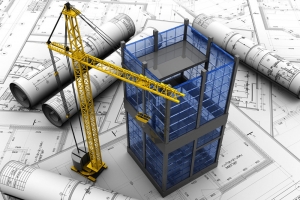 May 16, 2016 Valery Leonov: “Thanks to the expertise, it is possible to significantly reduce the estimated cost of the project”
May 16, 2016 Valery Leonov: “Thanks to the expertise, it is possible to significantly reduce the estimated cost of the project”
Jun 7 2016 The work of the Department on the introduction of new series of residential buildings was approved by the ONTS
